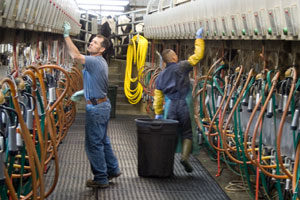Despite being considered the engine that drives the world’s economy, energy is something many of us take for granted, and even more of us don’t understand. But energy is worth understanding, especially while the economy still struggles for stability. After all, unlike feed, bedding and other necessities, energy is something you can reduce to help you save money, all without compromising your operations.
The American Council for an Energy-Efficient Economy , or ACEEE, estimates farmers nationwide spend about $10 billion on energy every year. For dairy operations, energy costs rank in the top five expenses.

In dairy operations, 25 percent of electricity use on dairy farms is to power milk chilling systems, while 24 percent of electricity is consumed for lighting, according to a study by the New York State Energy Research and Development Authority . Vacuum pumps, at 17 percent, and ventilation, at 22 percent, round out the top users of electricity on dairy farms.
By reducing the energy you consume at your dairy operations, you can reduce your costs, help improve the environment, and help secure reliable electricity for the future by reducing strain on the stressed electrical grid.
The electrical grid is so stressed, in fact, that the electricity industry will have to spend an estimated $1.5 trillion to $2 trillion to upgrade its infrastructure to accommodate the growing demand for electricity.
From Point A to Point B
According to the Energy Information Administration , 50 percent of the U.S.’ electricity is derived from coal-burning power plants. The remaining half is created by a combination of natural gas (21.6 percent), nuclear (19.4 percent), hydroelectric conventional (5.8 percent) and other methods.
After the electricity is generated, the voltage is immediately increased and, as a result, the wattage decreased in order for the electricity to safely transmit over wires. The electricity then travels to a transformer at a substation in order to reduce the voltage and increase the watts, readying the electricity for consumer use.
But it’s not done yet. The electricity then travels to a pole near your facilities, where a transformer on the pole – the large canister-looking devices – again reduces the voltage so that it can safely be used at your location.
After it travels to your facility, your machines and other electric devices use the electricity and send it to the ground wire that safely disperses the electricity into the ground.
It’s a simple cycle, in theory, but there are spikes and surges that disrupt the perfect circles, creating “dirty power.” Examples of dirty power include bad grounds, large loads, or a surge of power when a device that consumes a lot of electricity is turned on, or even lightning strikes.
Dirty power can affect your processes and your equipment, causing premature failure of electronic components – costing you money in maintenance, repairs and downtime.
By implementing energy-efficient technology at your dairy operations, you can reduce the risk of downtime and maintenance by reducing the threat of dirty power.
You’ll also be helping the environment.
As a result of burning coal – and to a lesser degree, natural gas – to create energy, greenhouse gases are emitted into the atmosphere as a byproduct of burning fossil fuels.
Greenhouse gases, specifically carbon dioxide, are blamed for climate change.
By implementing energy-efficient technology, you are helping displace the toxic gases and helping improve the air we breathe, by simply using less electricity and therefore reducing the need for power utilities to generate electricity.
And energy-efficient technologies will help you produce a gallon of milk cheaper, since you’ll be paying less for your operations. The less it costs you to produce milk, the longer you’re likely to stay in business.
Where to start?
There are many energy-efficient technologies available to dairy producers that can reduce energy consumption and costs, while improving operations at the farm.
An Iowa farm will save nearly $10,000 a year in energy costs as a result of installing a high-efficiency milk chilling system. After changing its inefficient lighting with fluorescent technology, a Wisconsin farm is saving 50 percent on its light-related electricity costs.
And Wim Hammink, who owns the Hammink Dairy with his family in South Dakota, has saved significantly by deploying a variety of energy-saving technologies and processes, everything from changing the lighting he uses to recycling cows’ solid waste for bedding, reducing the energy spent transporting bedding bought elsewhere.
“We’re always looking for ways to be more efficient and implement energy savings at the dairy,” Hammink said. “We try to utilize the most advanced technology all the time, and I think we’ve gained a lot of efficiencies recently.”
Like Hammink, many dairy producers are deploying energy-efficiency equipment to offset rising electricity prices and counter low milk prices. Understanding how electricity gets from power plant to your operations is the first step in understanding how you can reduce consumption, reduce costs and reduce your impact on the environment. PD

-
Mike Ontrop
- National Sales Manager
- Agricultural Division
- Email Mike Ontrop




